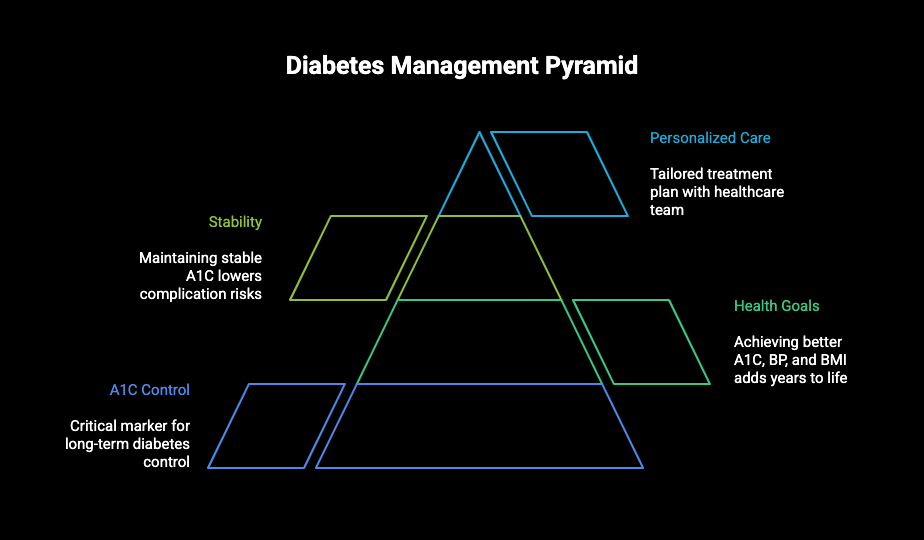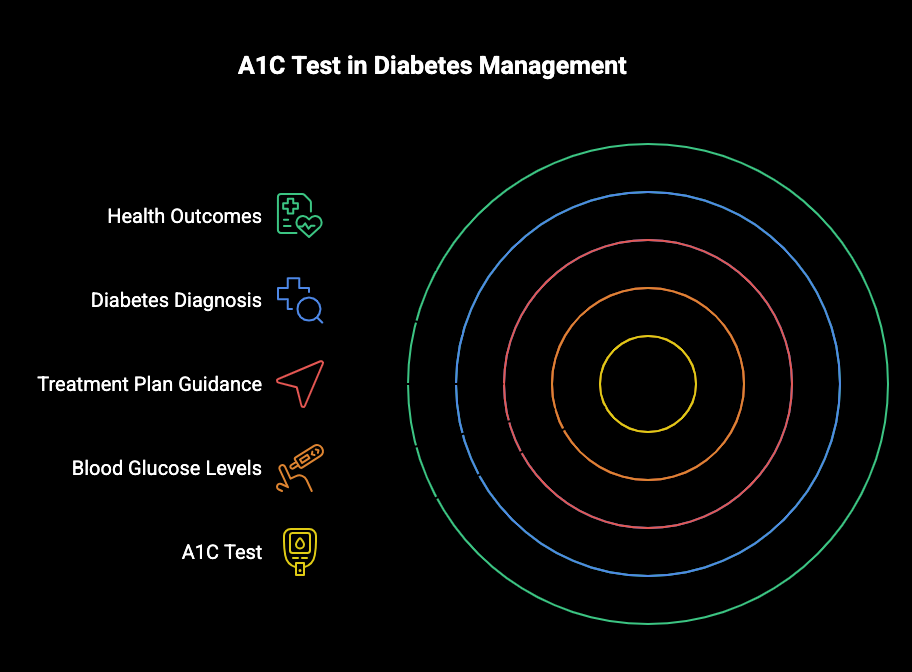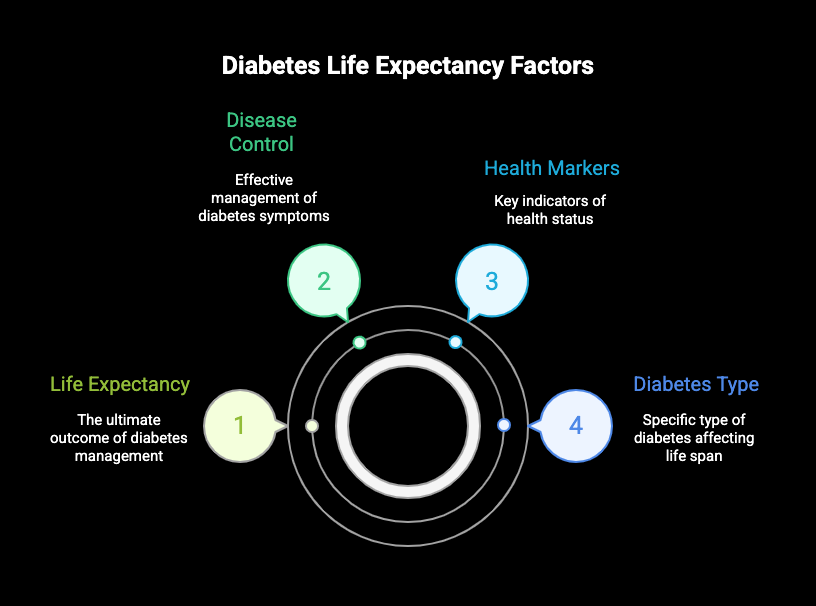
Key Highlights
Here are the main takeaways about A1C and life expectancy for diabetics:
- Your A1C level is a critical marker for long-term diabetes control and significantly influences your life expectancy.
- Research shows a “U-shaped” link between A1C and mortality, where both very high and very low levels can increase health risks.
- Achieving better A1C, blood pressure, and BMI goals can add years to your life, with younger individuals seeing the greatest benefit.
- Maintaining stable A1C levels over time is key to lowering the risk of complications like heart and kidney disease.
- Effective diabetes care involves creating a personalized treatment plan with your healthcare team to find the right A1C target for you.

Introduction
If you’re living with diabetes mellitus, you likely know the importance of monitoring your health. One of the most common terms you’ll hear is “A1C.” But what does this number truly mean for your long-term health and life expectancy? Understanding the connection between your A1C and overall well-being is a powerful step in your diabetes care journey. This article will explore how glycemic control, measured by A1C, can impact your future and what you can do to improve your outlook.
Understanding A1C and Its Role in Diabetes
The A1C test is a cornerstone of modern diabetes management. It gives you and your doctor a picture of your average blood glucose levels over the past few months, offering valuable insights that daily checks might miss. Think of it as a long-term report card for your blood sugar.
Following the standards of medical care, this measurement helps guide your treatment plan and is used not only for diabetes diagnosis but also for monitoring how well your management strategy is working. Let’s look closer at what A1C is and why it’s so important for your health.

Statistics on Life Expectancy for People with Diabetes
People with diabetes mellitus generally have a shorter life span than the general population, but the gap is closing thanks to better disease control. Research shows that managing key health markers can significantly extend life expectancy. While much data focuses on type 2 diabetes, some studies indicate that individuals with type 1 diabetes may face a greater reduction in life years compared to those with type 2.
A study based on data from the National Center for Health Statistics highlighted how improving various health metrics can add years to your life. For adults with type 2 diabetes, moving from the highest-risk quartile to a lower-risk one for certain biomarkers was associated with significant gains.
Here is a breakdown of the potential gains in life expectancy from improving key health factors:

|
Biomarker |
Improvement Scenario |
Potential Life Years Gained |
|---|---|---|
|
A1C |
From 9.9% down to 7.7% |
3.4 years |
|
Body Mass Index (BMI) |
From >36 down to <25 |
3.9 years |
|
Systolic Blood Pressure |
From >144 mm Hg down to <120 mm Hg |
1.9 years |
|
LDL Cholesterol |
From >122 mg/dL down to <70 mg/dL |
0.9 years |
The Impact of Age, Duration of Diabetes, and A1C
The impact of A1C on life expectancy is not the same for everyone. Your age, how long you’ve had diabetes, and your overall health all play a role. For instance, the benefits of tight blood glucose control are often most pronounced in younger individuals.
A study of diabetes patients found that achieving treatment goals at an earlier age can lead to greater gains in life expectancy. For example, a 50-year-old who improves their A1C and other risk factors has more potential life years to gain than an 80-year-old with the same improvements. This is because younger individuals have a longer time horizon over which the benefits of reduced complications can accumulate.
Several factors influence how A1C affects your life expectancy:
- Age at Diagnosis: Being diagnosed at a younger age means a longer lifetime exposure to high blood sugar, increasing the risk of complications if not well-managed.
- Duration of Diabetes: The longer you live with diabetes, the more critical consistent A1C control becomes to prevent the cumulative damage that shortens life.
- Overall Health: The presence of other conditions, like heart or kidney disease, can amplify the negative impact of poor A1C control.
Effect of Stable A1C on Mortality Risk
When it comes to A1C, it’s not just about the number—it’s also about stability. Having a consistent A1C level over time, without major ups and downs, is a strong indicator of good diabetes control. This stability, often called low glycemic variability, is associated with a lower risk of complications.
Studies suggest that avoiding large swings in your blood sugar can significantly reduce your overall mortality risk. Let’s look at the benefits of maintaining a steady A1C and what the research says about its impact.
Medication Approaches and Innovations
Medication is a cornerstone of diabetes treatment for many people. Your doctor will work with you to find the right medication—or combination of medications—to help you achieve your glucose control targets safely.
For type 2 diabetes, metformin is often the first-line medication prescribed. However, the world of diabetes medication has expanded dramatically. Newer classes of drugs not only lower blood sugar but also offer additional benefits, like promoting weight loss and protecting the heart and kidneys. Healthcare professionals are increasingly using these innovative treatments to create more effective, personalized plans.
Some key medication approaches include:
- GLP-1 Receptor Agonists: These injectable or oral medications help lower blood sugar, support weight loss, and have proven cardiovascular benefits.
- SGLT2 Inhibitors: These oral pills help the kidneys remove excess sugar from the body and are known to protect against heart failure and kidney disease progression.
Finding the ideal A1C range to increase lifespan often involves using these modern medications to achieve a target between 6.5% and 7.5%, depending on individual factors.
Lifestyle Changes to Support Healthy A1C
Medication is important, but lifestyle changes are the foundation of good diabetes control. The choices you make every day regarding food, activity, and overall wellness have a profound impact on your A1C and long-term health.
Weight loss is one of the most effective strategies for improving A1C, especially for those with a high body mass index (BMI). Data from a National Health and Nutrition Examination Survey (NHANES) based study showed that reducing BMI from over 36 to under 25 was associated with a potential gain of 3.9 life years [2].
Here are some powerful lifestyle changes to support a healthy A1C:
- Eat a Balanced Diet: Focus on whole foods, including vegetables, lean proteins, and complex carbohydrates. Limit sugary drinks and processed foods.
- Get Regular Exercise: Aim for at least 150 minutes of moderate-intensity activity, like brisk walking, each week.
- Quit Smoking: Smoking worsens circulation and increases insulin resistance, making diabetes control more difficult.
Achieving an ideal A1C range to increase your lifespan is often a result of combining these healthy habits with the right medical treatment.
Conclusion
In conclusion, understanding A1C levels is crucial for diabetics seeking to enhance their life expectancy. By maintaining optimal A1C ranges, individuals can significantly reduce the risks associated with various complications, thereby leading to a healthier and longer life. It’s important to recognize the individual factors that influence these targets and to adopt effective strategies—such as medication management, lifestyle changes, and regular monitoring—to achieve stable A1C levels. As you embark on this journey towards better health, remember that informed choices can make all the difference. If you’re ready to take control of your diabetes management, get in touch for a free consultation and start your path to improved well-being today!
Frequently Asked Questions
How many years of life can be gained with good A1C control?
Good A1C control can add several years to your life. One study found that for diabetes patients, lowering A1C from 9.9% to 7.7% was associated with a 3.4-year gain in life expectancy [2]. Combining good diabetes control with managing other risk factors like weight and blood pressure can lead to even greater gains.
Does aiming for too low an A1C increase health risks?
Yes, aiming for a very low A1C can be risky. It increases the chance of severe hypoglycemia (low blood glucose levels), which can be dangerous. Research also shows that both very low and very high A1C levels are linked to a higher mortality risk, making a balanced approach to glucose control essential.
What are current recommendations for A1C targets to extend life?
According to the American Diabetes Association, a general A1C target for many adults is less than 7%. However, these treatment goals are personalized. Your doctor will consider your age, health status, and other factors to set a safe and effective A1C target for you, which may be higher or lower.
References [1] Yu, J., Hua, H. & Yin, M. U-shaped association between HbA1c and all-cause mortality in CVD patients with diabetes. Sci Rep 14, 28386 (2024). Available at: https://www.nature.com/articles/s41598-024-80116-8 [2] Kianmehr H, et al. Potential Gains in Life Expectancy Associated With Achieving Treatment Goals in US Adults With Type 2 Diabetes. JAMA Netw Open. 2022;5(4):e227705. Available at: https://jamanetwork.com/journals/jamanetworkopen/fullarticle/2791200


